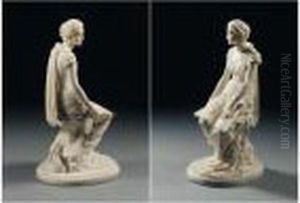Hamo Thornycroft Paintings
Sir William Hamo Thornycroft was an influential British sculptor, born on March 9, 1850, in London, England. He was part of a family deeply involved in the arts; his parents, Thomas Thornycroft and Mary Francis Thornycroft, were both notable sculptors, which naturally inclined Hamo Thornycroft to follow in their footsteps. He initially studied under his father before attending the Royal Academy Schools, where he further honed his skills and developed his artistic vision.
Thornycroft emerged as a leading figure in the New Sculpture movement, which sought to revitalize sculpture in Britain by introducing more dynamic and realistic qualities to statues, moving away from the rigid neoclassicism that had dominated the Victorian era. His works often reflected themes of beauty, heroism, and national pride, embodying a sense of movement and emotion that was innovative for his time.
One of his most famous works is the statue of Alfred the Great located in Winchester, unveiled in 1899, which exemplifies his approach to sculpture. Thornycroft's contributions to the field were recognized with numerous honors, including his election to the Royal Academy in 1888 and his knighthood in 1917. Beyond his public commissions, he also created smaller pieces, busts, and statuettes, which were highly regarded for their exquisite detail and expressive qualities.
Hamo Thornycroft's legacy is significant in the realm of British sculpture. His influence extended beyond his own works, as he was a mentor to a new generation of sculptors. He played a critical role in the transition of British sculpture towards modernism, bridging the gap between the academic traditions of the 19th century and the emerging styles of the 20th century. Thornycroft passed away on December 18, 1925, leaving behind a body of work that continues to be celebrated for its artistic merit and historical importance.
